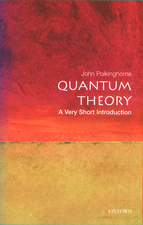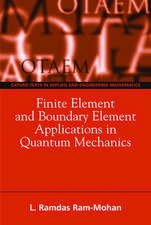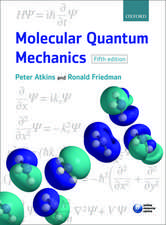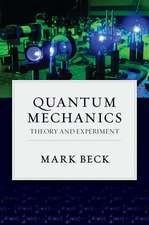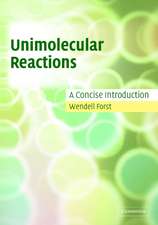Energy Density Functional Theory of Many-Electron Systems: Understanding Chemical Reactivity, cartea 4
Autor Eugene S. Kryachko, Eduardo V. Ludeñaen Limba Engleză Hardback – 28 feb 1990
| Toate formatele și edițiile | Preț | Express |
|---|---|---|
| Paperback (1) | 1842.79 lei 43-57 zile | |
| SPRINGER NETHERLANDS – 28 sep 2011 | 1842.79 lei 43-57 zile | |
| Hardback (1) | 1849.41 lei 43-57 zile | |
| SPRINGER NETHERLANDS – 28 feb 1990 | 1849.41 lei 43-57 zile |
Din seria Understanding Chemical Reactivity
- 18%
 Preț: 1221.51 lei
Preț: 1221.51 lei - 18%
 Preț: 1240.16 lei
Preț: 1240.16 lei - 15%
 Preț: 638.76 lei
Preț: 638.76 lei - 24%
 Preț: 798.19 lei
Preț: 798.19 lei - 18%
 Preț: 734.44 lei
Preț: 734.44 lei - 18%
 Preț: 952.40 lei
Preț: 952.40 lei -
 Preț: 391.40 lei
Preț: 391.40 lei - 18%
 Preț: 951.29 lei
Preț: 951.29 lei - 18%
 Preț: 1227.67 lei
Preț: 1227.67 lei -
 Preț: 386.22 lei
Preț: 386.22 lei - 15%
 Preț: 645.79 lei
Preț: 645.79 lei - 18%
 Preț: 1832.08 lei
Preț: 1832.08 lei - 18%
 Preț: 901.11 lei
Preț: 901.11 lei - 18%
 Preț: 946.87 lei
Preț: 946.87 lei - 15%
 Preț: 577.22 lei
Preț: 577.22 lei - 15%
 Preț: 635.47 lei
Preț: 635.47 lei - 18%
 Preț: 1229.91 lei
Preț: 1229.91 lei -
 Preț: 390.63 lei
Preț: 390.63 lei - 15%
 Preț: 595.86 lei
Preț: 595.86 lei - 18%
 Preț: 951.29 lei
Preț: 951.29 lei - 18%
 Preț: 954.93 lei
Preț: 954.93 lei - 18%
 Preț: 1227.84 lei
Preț: 1227.84 lei - 18%
 Preț: 1835.53 lei
Preț: 1835.53 lei - 18%
 Preț: 950.66 lei
Preț: 950.66 lei
Preț: 1849.41 lei
Preț vechi: 2255.38 lei
-18% Nou
Puncte Express: 2774
Preț estimativ în valută:
353.89€ • 370.42$ • 294.54£
353.89€ • 370.42$ • 294.54£
Carte tipărită la comandă
Livrare economică 31 martie-14 aprilie
Preluare comenzi: 021 569.72.76
Specificații
ISBN-13: 9780792306412
ISBN-10: 0792306414
Pagini: 850
Ilustrații: XIII, 850 p.
Dimensiuni: 155 x 235 x 46 mm
Greutate: 1.38 kg
Ediția:1990
Editura: SPRINGER NETHERLANDS
Colecția Springer
Seria Understanding Chemical Reactivity
Locul publicării:Dordrecht, Netherlands
ISBN-10: 0792306414
Pagini: 850
Ilustrații: XIII, 850 p.
Dimensiuni: 155 x 235 x 46 mm
Greutate: 1.38 kg
Ediția:1990
Editura: SPRINGER NETHERLANDS
Colecția Springer
Seria Understanding Chemical Reactivity
Locul publicării:Dordrecht, Netherlands
Public țintă
ResearchCuprins
1. Energy density functional theory: historical and bibliographic sketch.- 1.1. The Thomas-Fermi theory and its sequels.- 1.2. One-electron equations.- 1.3. Bibliographic sketch Monographies and books.- 2. Many-electron wavefunctions, density matrices, reduced density matrices and variational principles.- 2.1. Pure states and emsembles in quantum mechanics.- 2.2. Reduced density matrices.- 2.3. Spin structure of wavefunctions and reduced density matrices.- 2.4. Variational principle in the Schrödinger picture of quantum chemistry.- 3. The one-electron density.- 3.1. The meaning of the one-electron density.- 3.2. The one-electron density and molecular structure.- 3.3. Charge distributions and atomic charges.- 3.4. Quantum mechanics of an atomic fragment.- 3.5. Molecular structure and its relation to topologic properties of one-electron densities.- 3.5.b. Catastrophe points and their relation to the change in molecular structure.- 4. An Introduction to density functional theory from the perspective of the independent-particle model and its corrections.- 4.0. Preamble.- 4.1. The Hartree-Fock variational approach.- 4.2. The exact level.- 4.3. The kinetic energy term.- 4.4. The N-representability problem for D2 and ?.- 5. The Thomas-Fermi energy density functional and its generalization.- 5.1. Formulation of the Thomas-Fermi model for atoms and ions.- 5.2. Leading quantum corrections to the Thomas-Fermi atom.- 5.3. Post Thomas-Fermi-Dirac-von Weizsaker developments in density functional theory.- 5.4. Molecular structure and molecular interactions from the perspective of the Thomas- Fermi theory and its extensions.- 6. Foundations of density functional theory.- 6.0. Preamble.- 6.1. Correspondence between ground-state one-electron densities and external potentials.- 6.2.v-representability of one-electron densities.- 6.3 N-representability of one-electron densities.- Problems.- 6.4. The second Hohenberg-Kohn theorem.- 6.5. Universal functionals for non-v-representable one-electron densities.- 6.6. Approximate method for the determination of universal functional.- 6.7. A universal functional of the reduced first-order density operator.- 7. A rigorous formulation of the variational principle in density functional theory.- 7.1. Introductory remarks.- 7.2. Explicit construction of the energy density functional.- 7.3 Reformulation of the Hohenberg-Kohn theorems.- 7.4. The spin-density functional formalism.- 7.5. Density functional theory for excited states.- 7.6 The non-adiabatic energy density functional theory.- 7.7. The concept of fractional occupation numbers in density functional theory.- 7.8. N-representability of experimentally determined densities.- 7.9. The inverse problem in density functional theory.- 8. The self-consistent field concept in density functional theory.- 8.1. Introductory comments.- 8.2. The Slater-Kohn-Sham ansatz. Self-consistent field version of exchange-only density functional theory.- 8.3. The inverse problem in the Slater-Kohn-Sham ansatz.- 8.4 The Kohn-Sham ansatz.- 9. Synopsis and future trends.- 9.1 Density functional theory: overview and interfaces.- Theory of nuclear structure.- 9.2 Concluding remarks.

